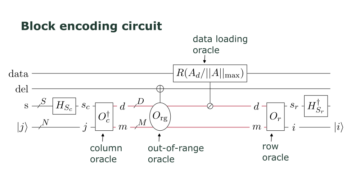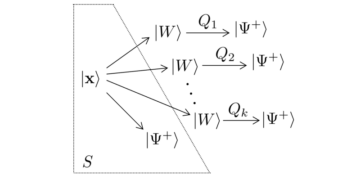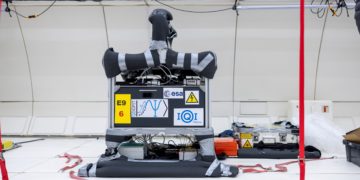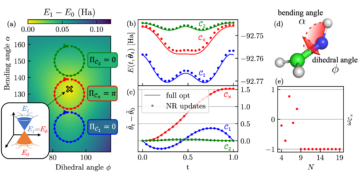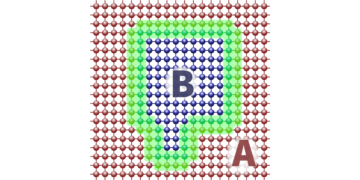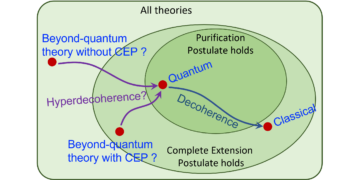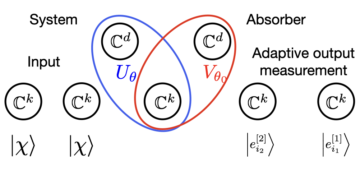Departamento de Física, Facultad de Ciencias Básicas, Universidad de Antofagasta, Casilla 170, Antofagasta, Chile
Find this paper interesting or want to discuss? Scite or leave a comment on SciRate.
Abstract
In this work, the concept of mutually unbiased frames is introduced as the most general notion of unbiasedness for sets composed by linearly independent and normalized vectors. It encompasses the already existing notions of unbiasedness for orthonormal bases, regular simplices, equiangular tight frames, positive operator valued measure, and also includes symmetric informationally complete quantum measurements. After introducing the tool, its power is shown by finding the following results about the last mentioned class of constellations: (i) real fiducial states do not exist in any even dimension, and (ii) unknown $d$-dimensional fiducial states are parameterized, a priori, with roughly $3d/2$ real variables only, without loss of generality. Furthermore, multi-parametric families of pure quantum states having minimum uncertainty with regard to several choices of $d+1$ orthonormal bases are shown, in every dimension $d$. These last families contain all existing fiducial states in every finite dimension, and the bases include maximal sets of $d+1$ mutually unbiased bases, when $d$ is a prime number.
Popular summary
► BibTeX data
► References
[1] S. Waldron, An Introduction to Finite Tight Frames, Applied and Numerical Harmonic Analysis, Birkhäuser/Springer, New York (2018). Draft version available here: https://www.math.auckland.ac.nz/ waldron/Preprints/Frame-book/frame-book.html.
https://www.math.auckland.ac.nz/~waldron/Preprints/Frame-book/frame-book.html.
[2] J. J. Benedetto, M. Fickus, Finite Normalized Tight Frames, Advances in Computational Mathematics, 18, 357–385 (2003).
https://doi.org/10.1023/A:1021323312367
[3] J. Kovacevic, A. Chebira, Life Beyond Bases: The Advent of Frames (Part I), IEEE Signal Processing Magazine 24,4, 86-104 (2007).
https://doi.org/10.1109/MSP.2007.4286567
[4] J.J. Benedetto, O. Yilmaz, A.M. Powell, Sigma-delta ($Sigma Delta$) quantization and finite frames, IEEE International Conference on Acoustics, Speech, and Signal Processing, 52, 5 (2004).
https://doi.org/10.1109/TIT.2006.872849
[5] Soo-Chang PeI, Min-Hung Yeh, An introduction to discrete finite frames, IEEE Signal Processing Magazine, 14, 6, 84 – 96 (1997).
https://doi.org/10.1109/79.637324
[6] T. Strohmer, R. W Heath, Grassmannian frames with applications to coding and communication, Applied and Computational Harmonic Analysis, 14, 3, 257-275 (2003).
https://doi.org/10.1016/S1063-5203(03)00023-X
[7] J. S. Tyo, Design of optimal polarimeters: maximization of signal-to-noise ratio and minimization of systematic error, Applied Optics, 41, 619-630 (2002).
https://doi.org/10.1364/AO.41.000619
[8] P. G. Casazza and G. Kutyniok. Finite Frames: Theory and Applications, Birkhäuser, Boston (2013).
https://doi.org/10.1007/978-0-8176-8373-3
[9] I. D. Ivanovic, Geometrical description of quantum state determination, Journal of Physics A: Mathematical and General, 14,3241–3245 (1981).
https://doi.org/10.1088/0305-4470/14/12/019
[10] W. Wootters, B. Fields, Optimal state determination by mutually unbiased measurements, Annals of Physics, 363-381 (1989).
https://doi.org/10.1016/0003-4916(89)90322-9
[11] J. M. Renes, Symmetric informationally complete quantum measurements, Journal of Mathematical Physics, 45, 2171-2180 (2004).
https://doi.org/10.1063/1.1737053
[12] R. B. A. Adamson, A. M. Steinberg, Improving Quantum State Estimation with Mutually Unbiased Bases, Physical Review Letters, 105, 030406, 105 ,3–16 (2010).
https://doi.org/10.1103/PhysRevLett.105.030406
[13] C. Spengler, M. Huber, S. Brierley, T. Adaktylos, and B. C. Hiesmayr, Entanglement detection via mutually unbiased bases, Physical Review A, 86, 022311 (2012).
https://doi.org/10.1103/PhysRevA.86.022311
[14] M. Mafu, A. Dudley, S. Goyal, D. Giovannini, M. McLaren, M. J. Padgett, T. Konrad, F. Petruccione, N. Lütkenhaus, and A Forbes, Higher-dimensional orbital-angular-momentum-based quantum key distribution with mutually unbiased bases, Physical Review A, 88, 3, 8, 032305 (2013).
https://doi.org/10.1103/PhysRevA.88.032305
[15] N. Brunner, D. Cavalcanti, S. Pironio, V. Scarani, and S. Wehner, Bell nonlocality, Reviews of Modern Physics, 86, 839 (2014).
https://doi.org/10.1103/RevModPhys.86.419
[16] A. Tavakoli, M. Farkas, D. Rosset, J.-D. Bancal, J. Kaniewski, Mutually unbiased bases and symmetric informationally complete measurements in Bell experiments, Science Advances 7, 7, 13 (2021).
https://doi.org/10.1126/sciadv.abc3847
[17] C. Paiva and E. Burgos and O. Jimenez and A. Delgado, Quantum tomography via equidistant states, Physical Review A, 82, 032115 (2010).
https://doi.org/10.1103/PhysRevA.82.032115
[18] O. Jimenez and L. Roa and A. Delgado, Probabilistic cloning of equidistant states, Physical Review A, 82, 022328 (2010).
https://doi.org/10.1103/PhysRevA.82.022328
[19] L. Roa and R. Salazar and C. Hermann-Avigliano and A. B. Klimov, Conclusive Discrimination among N equidistant pure states, Physical Review A 84 014302 (2011).
https://doi.org/10.1103/PhysRevA.84.014302
[20] M. C. Fickus, C. A. Schmitt, Harmonic Equiangular Tight Frames Comprised of Regular Simplices, Linear Algebra and its Applications, 586, 130-169 (2020).
https://doi.org/10.1016/j.laa.2019.10.019
[21] C. A. Schmitt, Harmonic Equiangular Tight Frames Comprised of Regular Simplices, Applied Mathematics Commons (2019).
https://doi.org/10.1016/j.laa.2019.10.019
[22] M. Fickus, B. Mayo, Mutually Unbiased Equiangular Tight Frames, IEEE Transactions on Information Theory, 67, 3, 1656 – 1667 (2020).
https://doi.org/10.1109/TIT.2020.3042735
[23] R. Beneduci, T. J. Bullock, P. Busch, C. Carmeli, T. Heinosaari, and A. Toigo, Operational link between mutually unbiased bases and symmetric informationally complete positive operator-valued measures, Physical Review A, 88, 15 (2013).
https://doi.org/10.1103/PhysRevA.88.032312
[24] R. J. Duffin and A. C. Schaeffer. A class of nonharmonic Fourier series. Transactions of the American Mathematical Society, 72:341–366 (1952).
https://doi.org/10.2307/1990760
[25] Casazza P.G., Kutyniok G., Philipp F. Introduction to Finite Frame Theory. In: Casazza P., Kutyniok G. (eds) Finite Frames. Applied and Numerical Harmonic Analysis. Birkhäuser, Boston (2013). Available online at https://www.math.tu-berlin.de/fileadmin/i26_fg-kutyniok/Kutyniok/Papers/IntroductionToFiniteFrames.pdf.
https://www.math.tu-berlin.de/fileadmin/i26_fg-kutyniok/Kutyniok/Papers/IntroductionToFiniteFrames.pdf
[26] M. A. Sustik, J. A. Tropp, I. S. Dhillon, R. W. Heath Jr, On the existence of equiangular tight frames, Linear Algebra and its Applications, 426, 619–635 (2007).
https://doi.org/10.1016/j.laa.2007.05.043
[27] M. Fickus, D. G. Mixon, Tables of the existence of equiangular tight frames, arXiv: 1504.00253 [math.FA](2015).
https://doi.org/10.48550/arXiv.1504.00253
[28] P. O. Boykin, M. Sitharam, M. Tarifi, P. Wocjan, Real Mutually Unbiased Bases, arXiv:quant-ph/0502024v2 (2005).
https://doi.org/10.48550/arXiv.quant-ph/0502024
arXiv:quant-ph/0502024v2
[29] T. Durt, B. Englert, I. Bengtsson, K. Życzkowski, On mutually unbiased bases, International Journal of Quantum Information, 8, 4, 535–640 (2010).
https://doi.org/10.1142/S0219749910006502
[30] P. Raynal, X. Lü, and B. Englert, Mutually unbiased bases in six dimensions: The four most distant bases, Physical Review A, 83, 6, 9 (2011).
https://doi.org/10.1103/PhysRevA.83.062303
[31] I. Bengtsson, W. Bruzda, A. Ericsson, J. Larsson, W. Tadej, K. Zyczkowski, Mutually unbiased bases and Hadamard matrices of order six, Journal of Mathematical Physics, 48, 052106 (2007).
https://doi.org/10.1063/1.2716990
[32] D. Goyeneche, Mutually unbiased triplets from non-affine families of complex Hadamard matrices in dimension 6, Journal of Physics A: Mathematical and Theoretical, 46, 10, 105301 (2013).
https://doi.org/10.1088/1751-8113%2F46%2F10%2F105301
[33] G. Zauner, Ph.D. thesis, University of Vienna, 1999. English version: Quantum designs: foundations of a noncommutative design theory, International Journal of Quantum Information, 9, 1, 445 (2011). Available at http://www.gerhardzauner.at/qdmye.html.
https://doi.org/10.1142/S0219749911006776
http://www.gerhardzauner.at/qdmye.html
[34] J. M. Renes, R. Blume-Kohout, A. J. Scott, C. M. Caves, Symmetric informationally complete quantum measurements, Journal of Mathematical Physics, 45, 2171 (2004).
https://doi.org/10.1063/1.1737053
[35] A. Scott, M. Grassl, Symmetric informationally complete positive-operator-valued measures: A new computer study, Journal of Mathematical Physics , 51, 042203 (2010).
https://doi.org/10.1063/1.3374022
[36] M. Grassl, Public Seminar entitled “Computing Numerical and Exact SIC-POVM”, March 29, 2021, Jagiellonian University, Krakow, Poland. Available online: https://chaos.if.uj.edu.pl/ZOA/files/semianria/chaos/29.03.2021.pdf.
https://chaos.if.uj.edu.pl/ZOA/files/semianria/chaos/29.03.2021.pdf
[37] M. Appleby, I. Bengtsson, M. Harrison, M. Grassl, G. McConnell, SIC-POVMs from Stark units, arXiv:2112.05552 [quant-ph] (2022).
https://doi.org/10.48550/arXiv.2112.05552
arXiv:2112.05552
[38] A. J. Scott, SICs: Extending the list of solutions, arXiv:1703.03993 [quant-ph] (2017).
https://doi.org/10.48550/arXiv.1703.03993
arXiv:1703.03993
[39] M. Grassl, A. J. Scott, Fibonacci-Lucas SIC-POVMs, Journal of Mathematical Physics, 58, 122201 (2017).
https://doi.org/10.1063/1.4995444
[40] A Kalev, G Gour, Mutually unbiased measurements in finite dimensions, New Journal of Physics, 16, 5, 053038 (2014).
https://doi.org/10.1088/1367-2630/16/5/053038
[41] G. Gour, A. Kalev, Construction of all general symmetric informationally complete measurements, Journal of Physics A: Mathematical and Theoretical, 47, 33, 335302 (2014).
https://doi.org/10.1088/1751-8113%2F47%2F33%2F335302
[42] D. M. Appleby, Symmetric informationally complete–positive operator valued measures and the extended Clifford group, Journal of Mathematical Physics, 46, 052107 (2005).
https://doi.org/10.1063/1.1896384
[43] L. Bos, S. Waldron, SICs and the elements of canonical order 3 in the Clifford group, Journal of Physics A: Mathematical and Theoretical, 52, 105301 (2019).
https://doi.org/10.1088/1751-8121/aafff3
[44] S. G. Hoggar, 64 lines from a quaternionic polytope, Geometriae Dedicata, 69,287–289 (1998).
https://doi.org/10.1023/A:1005009727232
[45] J. Czartowski, D. Goyeneche, K. Życzkowski, Entanglement properties of multipartite informationally complete quantum measurements, Journal of Physics A: Mathematical and Theoretical, 51, 305302 (2018).
https://doi.org/10.1088/1751-8121/aac973
[46] M. Appleby, S. Flammia, G. McConnell, J. Yard, SICs and Algebraic Number Theory, Foundations of Physics, 47(8), 1042–1059 (2017).
https://doi.org/10.1007/s10701-017-0090-7
[47] P. J. Davis, Circulant Matrices, Monographs and textbooks in pure and applied mathematics (1998).
[48] G. Greaves, J. H. Koolen, A. Munemasa, F. Szöllősi, Equiangular lines in Euclidean spaces, Journal of Combinatorial Theory, Series A, 138, 208-235 (2016).
https://doi.org/10.1016/j.jcta.2015.09.008
[49] P.W.H. Lemmens, J.J. Seidel, Equiangular lines, Journal of Algebra, 24, 494–512 (1973).
https://doi.org/10.1016/0021-8693(73)90123-3
[50] J.H. van Lint, J.J. Seidel, Equilateral point sets in elliptic geometry, Indagationes Mathematicae (Proceedings), 28, 335–348 (1966).
https://doi.org/10.1016/S1385-7258(66)50038-5
[51] S. Bandyopadhyay, P. Oscar Boykin, V. Roychowdhury, F. Vatan, A new proof for the existence of mutually unbiased bases, Algorithmica 34, 512–528 (2002).
https://doi.org/10.1007/s00453-002-0980-7
[52] M. Grassl, Private communication, October 2021.
[53] H. B. Dang, K. Blanchfield, I. Bengtsson, D. M. Appleby, Linear Dependencies in Weyl-Heisenberg Orbits, Quantum Information Processing, 12, 3449 (2013).
https://link.springer.com/article/10.1007/s11128-013-0609-6
[54] M. Khatirinejad, On Weyl-Heisenberg orbits of equiangular lines, Journal of Algebraic Combinatorics, 28, 333–34 (2007).
https://link.springer.com/article/10.1007/s10801-007-0104-1
[55] N. Wiener, Generalized harmonic analysis, Acta Mathematica 55, 117–258 (1930); A. Khintchine, Korrelationstheorie der stationären stochastischen Prozesse, Mathematische Annalen. 109, 1, 604–615 (1934).
https://doi.org/10.1007/BF02546511
[56] We acknowledge Marcus Appleby for noting this observation. See Chris Fuchs’s samizdat F14, p.1258.
[57] C. Fuchs, My Struggles with the Block Universe, arXiv:1405.2390 [quant-ph] (2014).
https://doi.org/10.48550/arXiv.1405.2390
arXiv:1405.2390
[58] D. M. Appleby, H. B. Dang and C. A. Fuchs, Symmetric Informationally-Complete Quantum States as Analogues to Orthonormal Bases and Minimum-Uncertainty States, Entropy, 16, 1484-1492 (2014).
https://doi.org/10.3390/e16031484
[59] C. A. Fuchs, M. C. Hoang, B. C. Stacey, The SIC Question: History and State of Play, Axioms 6 (3), 21 (2017).
https://doi.org/10.3390/axioms6030021
[60] A. Rényi, On measures of information and entropy, Proc. 4th Berkeley Symposium on Mathematics, Statistics and Probability 1960. 547–561 (1961).
[61] M. A. Ballester and S. Wehner, Entropic uncertainty relations and locking: Tight bounds for mutually unbiased bases, Physical Review A, 75, 022319 (2007).
https://doi.org/10.1103/PhysRevA.75.022319
[62] M. Fickus, Maximally Equiangular Frames and Gauss Sums, Journal of Fourier Analysis and Applications, 15, 413–427 (2009).
https://doi.org/10.1007/s00041-009-9064-2
[63] W.K. Wootters and D.M. Sussman, Discrete phase space and minimum- uncertainty states, arXiv:0704.1277 (2007).
https://doi.org/10.48550/arXiv.0704.1277
arXiv:0704.1277
[64] Falk Unger, unpublished notes, July 18th 2008. We thank Markus Grassl for noting the connection between our results and Falk Unger’s notes.
Cited by
[1] Alexey E. Rastegin, “Entropic uncertainty relations from equiangular tight frames and their applications”, arXiv:2112.12375.
[2] Ingemar Bengtsson and Basudha Srivastava, “Dimension towers of SICS: II. Some constructions”, Journal of Physics A Mathematical General 55 21, 215302 (2022).
[3] Beata Derȩgowska, Matthew Fickus, Simon Foucart, and Barbara Lewandowska, “On the value of the fifth maximal projection constant”, arXiv:2206.01596.
The above citations are from SAO/NASA ADS (last updated successfully 2022-11-04 05:42:26). The list may be incomplete as not all publishers provide suitable and complete citation data.
On Crossref’s cited-by service no data on citing works was found (last attempt 2022-11-04 05:42:24).
This Paper is published in Quantum under the Creative Commons Attribution 4.0 International (CC BY 4.0) license. Copyright remains with the original copyright holders such as the authors or their institutions.


